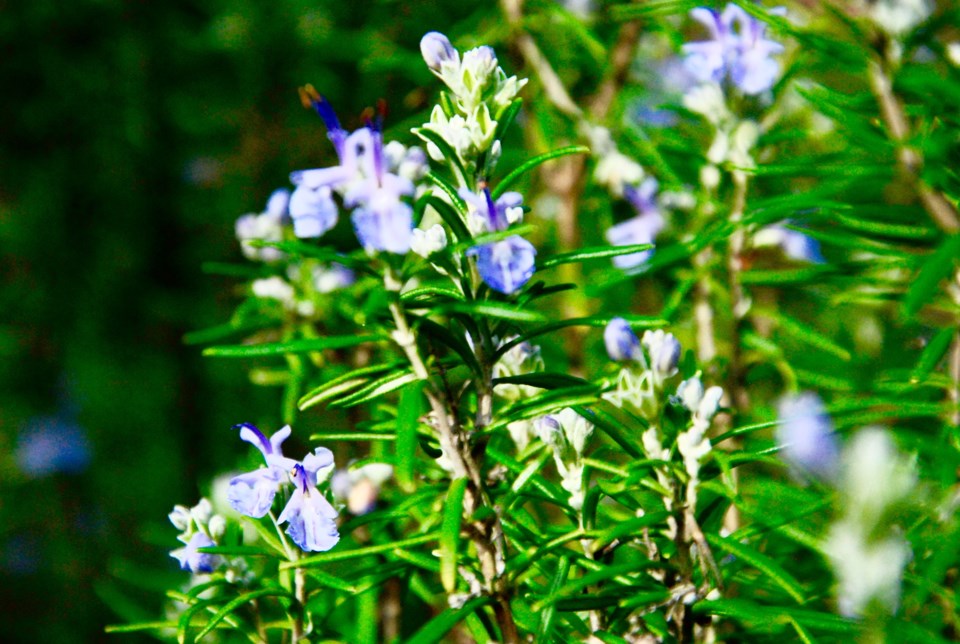LOUISE LOIK
EDITOR
Heidi Kuhrt and David Demner
have a beautiful home perched
high above a lake, facing across to
mountain views. Before the land
drops down to the lake, the land
has been built up to hold soil in
place for Mediterranean plants,
fruit trees and a hot tub.
It’s an idyllic October day and
lush rosemary bushes more than
a metre tall are still in bloom just
outside the doors of their bed and
breakfast, Bowen Island Hideaway.
There’s purple sage, wooly
thyme, a kiwi vine, three pear trees
grafted so that they bear five types
of pears. There’s also apple and
Italian plum trees. They have pots
and planters too with onions, and
parsley and even some flowers.
If you take a look in your cupboards
and fridge, you may notice
that your food will have travelled
an average 2,400 km to get to your
table. The Pinot Grigio is from
Italy; the Brie is from France, the
mandarin oranges from China.
The downside of great food and
drink from around the world is
that there’s a very high carbon cost
to the processing, packaging and
shipping of consumables from all
over the world. On the flipside,
Bowen’s mild climate and space
for gardens makes it easier to grow
what we eat and drink. .
David and Heidi can get food
from field to fork in less than 10
km. The couple and their kids are
part of a community-supported
farm near Collins Farm. Members
of that community help out on the
farm in exchange for a share in the
harvest.
“There’s tomatoes, tayberries,
blueberries, garlic, pumpkins, and
sometimes enough left over to sell,”
says Demner.
The family even have their own
chickens and an apiary on the community
farmland. This year, however,
the bees only made a small
amount of honey, possibly due to
our drought. Now, Demner says,
“any honey in the hive is food the
bees will need for themselves for
the winter. “
Demner and Kuhrt address their
own heating issues by incorporating
solar thermal or “heat differentiation
system,” which captures heat
even on cloudy days providing hot
water for the whole house, including
the B&B.
“It’s much more efficient than
photovoltaic in this climate,” adds
Demner.
In simple terms, this system uses
metal panels with a liquid running
through. “As the liquid heats up,
it turns to gas, the gas goes into a
compressor and is squeezed back
into liquid. Heat taken from the
gas gets concentrated and heats the
water,” he says.
“So, a heat differential system
means that it can generate heat if
the day is sunny and cold but not
really cold and no sun.”
On this day, it’s sunny and the
panels have no problem capturing
heat. The warm fall weather has
also meant a long growing season.
The family is still pulling up a
few cold-weather vegetables from
pots and planters around their
home. For Demner, that still isn’t
enough.
“When we moved in we had
some open deck space and I wanted
to put a green house there for
more efficient growing.“
Demner looked into hydroponics,
a system that grows plants
without the need for soil but is
heavily reliant on fertilizing. Then
he heard that someone was selling
an aquaponics system. Demner,
who has an engineering background,
was interested. He went
from thinking about a greenhouse
on the deck to bringing home a
whole closed-loop system for growing
food indoors.
Downstairs, in an unfinished
part of his basement, Demner set
up a series of five tanks. Two large,
table sized tanks are full of water
with a board suspended over the
water, The board had loonie-sized
holes in a grid and plants fill each
hole in the grid, dropping their
roots, while the rest of the plant is
suspended, down into the water.
The plants, Brussels sprouts, basil,
hot peppers and cabbage in this
case, are tall and lush.
Demner explains that the plants
absorb the nitrogen from fish feces
in the water, by doing this they act
like filters, allowing clean water
to flow back to the four bubbling
tanks full of varying sizes of fish.
The tanks themselves range in size
and shape from tall rain barrel to
large aquarium. It’s a simple process
and there’s also no damp or
fishy smell.
The tilapia in the tanks are a dull
grey fish with a mild flavour. The
fish are usually purchased from
growers as fingerlings, and then
grown to plate-size within the year.
“We’ll have friends over for dinner
and pull out three fish for a
meal, maybe once a week,” says
Demner.
From the time the fish are pulled
from the tank it takes around 25
minutes from tank to table, with
home grown greens grown downstairs
on the side. Now that’s fresh.
In spite of having both a home
office and a B&B business on site,
abundant local variety of foods and
flavourings, the family still feels the
need to head to the mainland for
some items and yes, some of those
things may come from far away.
Demner and Kuhrt are still miles
ahead of most in their commitment
eating locally. For most, being a
conscious consumer is a good first step.



